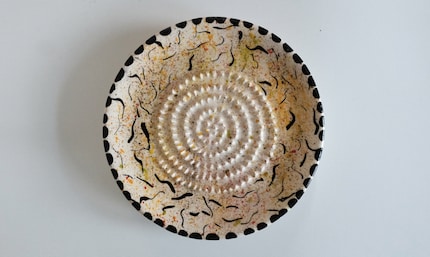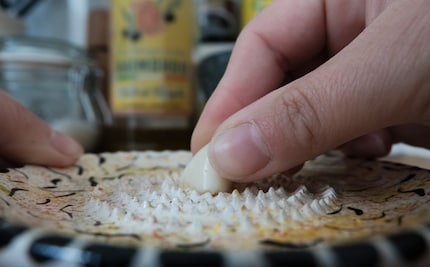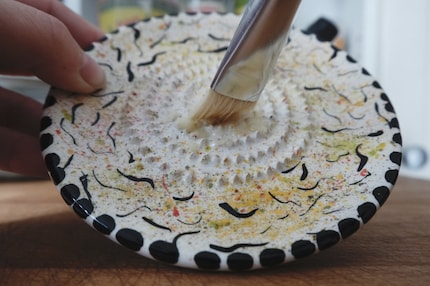
Product test
Who needs an onion chopper anyway? I do!
by Katja Fischer

My garlic press has been sitting in the drawer untouched for weeks. The reason: a knobbly plate that turns a clove of garlic into a fine paste within seconds.
I have a new favourite kitchen gadget. It doesn’t need electricity, it doesn’t take up much space and there are definitely no frills. It doesn’t even have an app. It’s a saucer-sized plate with lots of little teeth that act as a grating surface for garlic and ginger. The result is a much finer puree that you’d get from a garlic press. And the aroma is also said to be fuller. When you press garlic, a lot of pungent juice comes out, but there’s relatively little mild pulp.

In addition, your hands smell wonderfully garlicky afterwards. Although what’s a plus for me might be a deterrent for you. If so, you’re probably better off with the classic press.
I first encountered the ceramic grater in South Africa. I was in a small pottery workshop on the ground floor of Africa’s tallest residential building, the Ponte City in Johannesburg. I immediately noticed the many colourful plates in the corner of the small grey room, but I didn’t know what they were supposed to be used for. Instead of explaining, the potter showed me the whole process right then and there. He ran a peeled clove of garlic over the plate as if he were using an rubber on paper, and the whole thing only took five seconds. I’d have been no less amazed if he had conjured up four doves out of nowhere.
I immediately bought a plate with my last few rand.

Since then, it’s the only thing I’ve used to grate garlic cloves. I only have one tiny criticism about the last few millimetres of the grating process. The small pointed teeth get a bit uncomfortable on your fingers. I solve the problem by «impaling» the garlic with my fingernails as high up as possible instead of holding it. That way I can grate the whole clove. If your fingernails are too short for this, you’ll be left with a small amount of ungrated garlic.
Then you simply brush the paste out of the gaps with a brush. And it’s even easier to clean the grater afterwards. Just rinse it with water and you’re done. It still smells a bit like garlic afterwards, but that’s not a problem since it’s going to be used again for the same purpose anyway.

As it’s also called a «Spanish ceramic grater», most sources place its roots in Spain. The grater is said to have first appeared in the Mediterranean region in the 11th century, but there are also sources that attribute the invention to the Japanese in the 16th century. Whoever invented this great thing: thank you. I never would have thought that something so simple could delight me so much. And a kitchen «appliance» at that.
Mine – a unique creation – is no longer available to purchase. And you’d have to go to Johannesburg for the other pieces in the range. However, we do have a similar one in our shop. Although it comes in sterile white and is industrially manufactured, it works on the same principle. If you’d prefer something handmade without having to board a plane, here’s a little tip between us: just Google «ceramic grater». �
My life in a nutshell? On a quest to broaden my horizon. I love discovering and learning new skills and I see a chance to experience something new in everything – be it travelling, reading, cooking, movies or DIY.